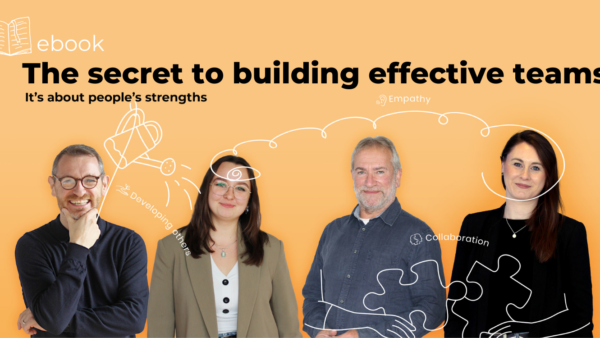Team development is squarely and firmly back on the agenda in most organisations. And because now more than ever, teams are working virtually, organisations need a route map for building successful virtual teams. Now it would be easy to say that building virtual teams is just the same as building teams that are co-located, and to some extent that’s true, but there are definite differences. So in today’s podcast, I want to share with you the strengths approach to building effective virtual teams.
My name’s Dr Paul Brewerton, the strengths guy, Founder and Chair of Strengthscope and Doctor of Organisational Psychology. I podcast at the top of the week to make sure that you have a top week and so that you’re still feeling on top by the bottom of the week. No one talks about the bottom of the week. I mean the end of the week. I know that’s kind of obvious. So without any more jiggery-pokery, let’s get to the heart of the matter: building effective virtual teams the strengths way.
The science behind effective virtual teams
First things first, I did podcast on effective virtual teamworking a little while back, when we were just coming into lockdown, so check that out for more tips and tricks. First up, as I did in that podcast, I want to summarise some of the reasons why there needs to be a method when you’re building effective virtual teams. And so here’s a summary of the research that’s out there:
- Trust among team members starts lower in virtual teams than in face-to-face teams, but over time, it can reach the same levels
- Formalising a virtual team’s goals, roles and communication methods at the start of the team’s journey improves their effectiveness later
- Shared leadership in virtual teams rather than traditional hierarchical leadership is associated with improved team performance; that means that team members should lead in their areas of expertise.
How to make virtual teams work successfully
So that’s the research, now to my guide on building effective virtual teams using the strengths approach. I have 5 main areas to consider, so let’s cover them off and that’ll give you a road map. My recommendation is that you consider each of these 5 areas when working with or within a team that you believe could use some development. Genuine team development takes time, needs real, honest conversations, effort and discipline to be truly valuable. I’m not talking here about flashbang teambuilding events or one off team get togethers (although those activities do have their own value, just within the context of something deeper and longer-term). I’m talking proper investment in making a team successful over weeks and months. So, how to make virtual teams work successfully?
1. Understand the impact of strengths individually and collectively to build trust
A podcast on building effective virtual teams the strengths way wouldn’t be much use if I didn’t give strengths a shout, would it? But there’s more, so much more, than just a shout out to strengths needed here. When done well, you can unlock team development if you apply strengths principles. To do this, you need to start by having a common language…a way of understanding strengths that everyone can grasp and use. The best way to do this is to find a strengths assessment tool that is valid, reliable and accessible. Like Strengthscope. In fact, by those criteria, Strengthscope is actually your only choice.
Individual strengths in virtual teams
Based on the strengths assessment, once the team has an understanding of what they love, what energizes them and what they are good at, you can start to understand how to get the best from everyone in the team individually and from the team as a whole.
At the individual level, get each member of the team to describe the strength or strengths that they would like to bring to the team to make it more successful. Like Strategic mindedness to spot threats to the team before they become risks. Or Relationship building to build out the team’s connections with key stakeholders. Or Optimism, to keep the team on a positive footing when facing adversity. Make this a habit: strengths share and strengths borrow as specifically and as practically as possible as frequently as you can. For example, ‘Jim, I’d like to call on your Strategic mindedness this week to help me finish off a paper I’m putting together on business opportunities and risks in a new market’.
Also, offer strengths at the start of meetings so that each person in the meeting can make a conscious choice about a strength that would help the meeting run well. Check in at the end of the meeting as to how well they have been able to use their strength, even how much others have valued it. This approach really deepens connections within a team, even early on its development and that can very quickly lead to greater trust developing within the team, which is one of the most challenging areas to develop in virtual teams, as I said earlier. Strengths-sharing fast-tracks trust-building. Trust me.
Collective strengths in virtual teams
Considering strengths collectively can also be a real eye-opener: imagine a team with a dominance of Enthusiasm, Decisiveness and Initiative strengths that most of them share but the team hasn’t realised that. So most of the team individually get very excited about new ideas, and also like to move quickly to put those ideas into practice. Particularly in virtual environments, there may be more of a tendency towards individual action, rather than collective, because team members may forget to consult, discuss and agree a collective way forward.
So in the case of our example team, that may lead to unintentional overlap, doubling up on work, inefficiency and then frustration, because they’re all off individually putting their passion projects into action without collaborating or checking in.
More effective then is the virtual team that considers its collective strengths and organises itself to get the most from them. Our team of enthusiastic, decisive initiators can point those strengths into discussion, evaluation of options, deciding on an agreed way forward and then organise their work to deliver the plan as efficiently as possible, with each team member playing to their areas of expertise, strength and skill. They can still use their powerful individual strengths, just in a way that’s aligned.
Now that intro to strengths in virtual teams is super-summary – if you want to know how to do that in practice – quickly, easily, with insight – I would highly encourage you to check out StrengthscopeTeam. That is exactly what we built it for.
2. Getting clarity of goals, roles and responsibilities for a virtual team
So now we’re moving from strengths specifically into developing good habits and disciplines in the team. And as I mentioned at the start in the research that’s been carried out on virtual teams, formalising a virtual team’s goals, roles, responsibilities and also communication methods is even more important in a virtual team than in a co-located team in terms of driving up team effectiveness and success.
There are many ways to do this, but being clear on team purpose and objectives is a really good start. Ask yourself and the team: what is the team for? What purpose does it serve? What does it deliver, what outcomes is it expecting to generate? What are its goals and objectives? However you ask these questions, when you get the answers from the team leader (or even better from a facilitated team discussion), try and boil it down to as few, simple statements of intent as possible, so that the team are all pulling the same direction and all buy into the same goals. Once these are agreed, particularly in a virtual team, come back to the objectives and purpose frequently, like at least each month, so that people continue to have them top of mind.
Individual responsibilities in virtual teams
Second point here, we’ve already touched on individual responsibilities when I described the research on shared leadership and why it’s important in virtual teams that each team member is super-clear on what they lead on because it’s their skill area, based on their expertise. When you’re not physically around each other as much, you lose those environmental cues that remind you what each person does, so having the clarity on who does what gives everyone a mental map of the team, as well as building a sense of confidence and meaning for each team member because they own something and feel valued for something that contributes to the overall goal.
Methods of communication for virtual teams
Final point, agreeing methods of communication for the team is also really important. I podcast on this in detail in my effective virtual team communication podcast, just a few weeks back, so check that out for more detail.
In summary, I would encourage you to be clear from the outset on your team communication do’s and don’ts (for example, in the Strengthscope team we use MS Teams as a default communication method, minimise WhatsApp communication outside work hours, and don’t expect a response to emails sent in the evening after work, etc.). Do whatever works for your team to set boundaries for everyone, so that everyone’s expectations are aligned. As I say, check out my effective virtual team communication podcast for more on this. Overall then, that’s goals, roles, responsibilities and communication done.
3. Building accountability in a virtual team
So once everyone in the team is clear on their role, and on the purpose and goals of the team, as well as being clear on how they are expected to contribute to the team using their strengths, skills and experience, it’s time to get crunchy. What I mean by that is that each member of the team will be required to take individual responsibility for actions and tasks allocated to them, along with dates and quality standards to deliver to. In a virtual team, this is even more important than when a team is co-located, because you won’t be able to have informal check-ins on task progress across the team unless you schedule them in.
Getting buy-in to task and project allocation
So, when developing effective virtual teams, everyone needs to be bought into decisions on tasks and projects allocated, the scope of these and be crystal clear on who is doing what. If people aren’t clear or if the boundaries are hazy, it may well be that some tasks won’t get completed in the way that was expected or in time. So make sure that meetings where actions are agreed are chaired well so that tasks are scoped, discussed, challenged and then agreed, as well as agreeing any check-in points along the way so that team members can support each other and also you can agree when a line manager check-in might be useful.
Giving feedback well in virtual teams
The next bit is where a lot of virtual team effectiveness comes unstuck: giving feedback well. At Strengthscope, we talk about BID and BIRD feedback (otherwise known as positive and constructive feedback) and my how to for doing that is at S1, E4: Great feedback in 3 steps. For now, considering virtual teamworking, it may be that people feel less comfortable giving feedback virtually than in person, but it is very important, so it needs to be planned, structured well and delivered clearly, objectively and with positive intent, if the team is going to develop a high level of accountability.
It’s really worth investing the time skill-building with the team to get team members comfortable with delivering feedback well because there’s so much baggage attached to it for many people, but it’s a learnable skill just like most other things at work and in life.
4. Dealing with change as a virtual team
The next step on the journey to developing effective virtual teams is to get the team change-able. Not changeable. Change-able, like able to deal well with change. Now there are some character strengths (like Flexibility, Resilience, Strategic mindedness and Optimism for example) that can be super-helpful during change. So I would encourage you to find out where these strengths are in the team and call on team members who have them to bring them to the party when they’re needed more.
The truth is that change is inevitable and everyone in the team will need to roll with changes the team needs to survive and thrive. So quick tips on doing this well:
- Get more change-positive team members to buddy with those who are less comfortable with change so that they can support and guide them through.
- Thinking of whatever change you need as an outcome, ask individual team members to consider which strengths they have that will get them there. Is it Efficiency to build and follow a plan, Results focus to get the change over the line, Critical thinking to find the problems with the change plan and de-risk it, etc, etc. That way, everyone gets to feel empowered to navigate through change using their own strengths.
- Encourage a focus on solutions so that there’s less stuck-ness on problems.
So that’s building agility and change readiness in effective virtual teams in a nutshell.
5. Continuous improvement and learning in virtual teams
The last area I’d like to consider is how to keep the team continuously improving. First up on this is to recognise and celebrate achievements and ideally to link these to strengths. So whatever successes have happened, ask team members which strength or strengths they used and which strength or strengths they valued in others to get the success that they did. Celebrating wins is even more important when you can’t get together in person, so do set aside the time for it, make it feel special and link it the success to what the team did so that you can all can learn from that success.
The same is true for things not going so well, although most teams spend long enough picking over the embers of what they deem to be their failures. Of course, there’s never really failure, only learning, so look for that learning, what we’ll do differently next time to build on what we’ve learned this time.
Getting feedback from team stakeholders
In this final habit area, it’s also important to bring in feedback…yes from team members to each other as we covered earlier, but also from key customers and stakeholders into the team, so that the team can get a sense of how they’re being seen externally as well as how they see themselves from the inside. That continuous improvement cycle will over time become more habituated and seeking out the feedback won’t feel so quite as threatening, as gathering and analysing feedback is seen more as an opportunity to keep growing and to keep improving.
So that’s continuing to stretch, learn and improve your virtual team. And that’s it!
I have taken you through there the strengths way of how to build effective virtual teams. In fact, it’s the Strengthscope way because every step I’ve talked you through is covered in our StrengthscopeTeam methodology.
Till next time, stay strong.
This podcast is available on all major podcast platforms. Find it on Apple podcasts, Spotify, Google podcasts, Stitcher, ACast, TuneIn, Breaker and Soundcloud. Make sure to subscribe to get them at the start of the working week!









